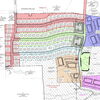
Processing Your Payment
Please do not leave this page until complete. This can take a few moments.
Bangor Savings creating 'all-in-one' waterfront campus along Penobscot River
 Photo / Jim Neuger
David Latulippe, left, a development partner of Bangor Savings Bank, with bank president and CEO Bob Montgomery-Rice, who says the new campus will accommodate 500 employees..
Photo / Jim Neuger
David Latulippe, left, a development partner of Bangor Savings Bank, with bank president and CEO Bob Montgomery-Rice, who says the new campus will accommodate 500 employees..
Bangor Savings Bank is expanding across Maine and beyond while upgrading its home base to a multi-million-dollar Penobscot River waterfront campus.
“Wow, this is coming along nicely,” says Bob Montgomery-Rice, the bank's president and CEO, on a recent visit to the building site, sporting a hardhat and dress shirt with Boston Red Sox 'B' logo cufflinks. He's counting on the new digs to keep current employees happy and lure new ones.
Maine's second-largest bank needs a bigger nerve center after seeing 16 straight years of earnings growth. In June it posted record earnings of nearly $25 million for the 2017 fiscal year, up 8.42% over 2016. In the past year it opened more than 31,000 new core deposit accounts, including 3,500-plus business accounts, and provided $370.7 million in home loans.
“We provide payroll services for approximately 3,300 companies across the country, in every state except Wyoming. For every 150 businesses we add into the mix, we need an additional person in Bangor to service those accounts,” says Montgomery-Rice. “The mortgage business is not that different. We were the No. 1 mortgage lender in Maine last year. That kind of growth and that kind of volume requires us to hire people to handle the back-office work, and the majority of those positions reside in Bangor.”
'All-in-one' campus
The 165-year-old Bangor Savings Bank, which ended its first year with $7,461 in assets, now has $3.66 billion on its books. Out of 800 employees statewide, 370 are in Bangor — which Montgomery-Rice sees going up to 400 when the new site opens. “We're always recruiting, that's just natural growth for us,” he says, confident the new site “could easily expand to 500.”
The future nerve center will house a four-story, 30,000-square foot building, on the site of a 1920-built edifice that had been vacant for more than a decade and was reportedly assessed at $1.8 million, and an adjacent 100,000-square-foot new construction still to be built.
David Latulippe of CJ Developers Inc. in Freeport has worked with Bangor Savings for the past five years on its statewide branch expansion drive. He says the waterfront project was made possible by combining unlisted properties from three previous owners, including the city of Bangor and the Quirk family.
“Typically I don't look for something that's for sale,” he says, “but what's the right site and then see if it could be made for sale.” He says it helped that the city, which owned the middle parcel where there's now a parking lot, had a long-term vision of developing the waterfront years after buying the land. He also prefers redeveloping a property over taking raw land.

With most of the interior demolition now done, Latulippe says that workers are preparing interior partitions and — literally — raising the roof. They'll also upgrade the windows to energy-efficiency standards while preserving the views of the river that once transported lumber from area sawmills.
“We looked at a lot of different sites and this one just happened to really work,” says Montgomery-Rice. “Plus the bank was founded in the heyday of timber — timber that was going down this river — so the historical significance of putting our headquarters along the river isn't an accident.”
Bullish on Bangor
As Bangor's biggest development project in recent years, the waterfront campus project is generating lots of local buzz and comes amid a downtown revival that's brought new stores and restaurants in recent years, and an arts space opening in September in the historic Nichols Block Building.
“I think it's exciting that the board of the bank and the leadership are as excited about Bangor as we are,” says Tanya Emery, the city's community and economic development director. “It's a great sign.” She adds that Montgomery-Rice “is very personally invested in making sure that the commitment to Bangor is backed up, not just that we share a name.”
As for his own assessment of Bangor's economic health, Montgomery-Rice says the city has “come a long way” in the past decade and a half. He looks forward to having all staff on one campus, where all offices will be the same size with no pecking order, to foster better communication among project teams. The smaller building, to be ready next June, will mainly house employees who interact directly with customers, including wealth-management clients, while the larger one, slated for early 2019, will house back-office workers, including those working in payroll and tax services and technical operations, all of whom will relocate from the Maine Business Enterprise Park. After the move, South Street will be renamed Hamlin Way, after the bank's founding president, Elijah Hamlin (brother of Hannibal Hamlin, a U.S. senator from Maine and Abraham Lincoln's first vice president).
The campus will also have a gym, basement café, bike storage and a walking path down to the riverbank, already a draw for lunchtime food trucks. “Having the right culture is really important. We want people to want to work here,” says Montgomery-Rice.
He says that while finding talent today isn't easy, it's not an insurmountable obstacle: “We find people everywhere, whether through contacts at other banks, non-traditional employers, from area universities or other Maine businesses ... It's a constant focus for us, and if it wasn't constant we'd have a problem.”
He boils the bank's growth strategy down to hiring the right employees, making sure they're happy and providing “awesome” customer service and supporting the community.
Different paths
Of the top three Maine-based banks, Bangor Savings is the only one opting for organic growth over acquisitions. Bar Harbor Bank & Trust, owned by Bar Harbor Bankshares (NYSE: BHB), in January snapped up Lake Sunapee Bank Group of Newport, N.H., in a $143 million all-stock deal that gave it a presence in Vermont and New Hampshire and more than doubled its assets, to $3.3 billion.
Market-leading Camden National Bank (NASDAQ: CAC) bought the Bank of Maine in October 2015 for $135 million in cash and stock to extend its reach into southern Maine. It's been in the greater Bangor region since 1997 where it currently employs 63 people including branch staff, management and various support personnel. Why so much interest in the Queen City? “We recognize its importance as an economic and social hub in Maine and view it as a growth area for us,” says president and CEO Gregory A. Dufour, who grew up in Old Town. “We find that Bangor is a good employment market for us.”
As a mutual savings bank with no stockholders and no obligation to publish quarterly earnings, Bangor Savings Bank has the freedom to make investments without an immediate payback. It's been spending money lately on new branches, including two in Portland, one in Augusta, one in Brunswick and a Portsmouth loan production office in July where developer Latulippe is eyeing “two or three” downtown locations for its first branch outside of Maine.
Like others in the sector it's also investing in technology, becoming Maine's first bank — and one of only two in New England so far — to provide dual-technology debit cards with chips as well as higher-security near-field communication (NFC) known as tap and pay. It was also the first local financial institution in Maine to offer customers all three mobile wallet solutions — Android, Apple and Samsung Pay — for credit and debit card uses.
Since it was founded in 1852, Bangor Savings has made only two acquisitions of note: the 1998 purchase of 28 Fleet Bank of Maine branches that opened the door to statewide expansion, and last year's buy of Portland gift card firm Buoy Local, which it plans to turn into a statewide program via a mobile application due to be rolled out in coming months. “The reason we bought the business is because it's very brand-centric and aligned with our own. It just needs to be energized and scaled up,” says Jamey Doughty, senior vice president and director of product management and digital banking.
While the move outside the traditional banking realm may seem unusual, consultant Erin Hurley of Hurley Solutions Inc. in Portland says it makes sense. “Banks across the country are seeking ways to diversify their business model, generate non-interest income, and deepen existing relationships with clients so as to remain relevant,” she says. “So I am not surprised by this acquisition, and I suspect we will see more from other banks in the not too distant future.”
But she doesn't see any risk of Bangor Savings itself falling prey to a takeover because of its set-up as a mutual savings bank. “Given there is no stock, the risk of a takeover is minimized, which can be an attractive attribute for customers seeking a bank that will remain relatively unchanged in name and mission.”














Comments